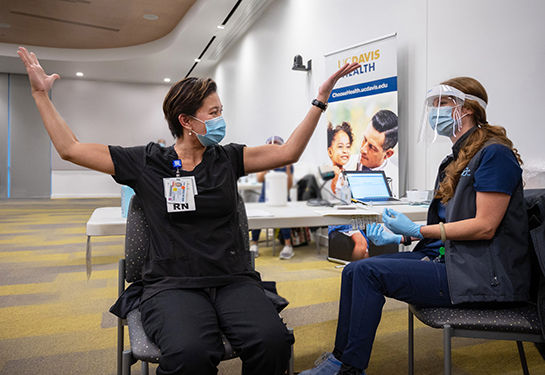What to know about the new COVID-19 booster shots
Experts weigh in on the new shots targeting the Omicron subvariants
The Centers for Disease Control and Prevention (CDC) has signed off on new versions of the Moderna and Pfizer-BioNTech COVID-19 vaccines after the Food and Drug Administration (FDA) authorized the shots earlier in the week.
The Covid-19 boosters are bivalent shots, meaning they target two strains of the SARS-CoV-2 virus. This includes both the original strain that all previous vaccines have protected against and the Omicron subvariants BA.4 and BA.5.
Dean Blumberg, chief of pediatric infectious diseases at UC Davis Children’s Hospital and Natascha Tuznik, associate clinical professor of infectious diseases at UC Davis Health, answer questions about what you need to know about the new vaccines.
What do the new boosters contain?
These updated COVID-19 booster shots contain coding for the spike protein for two different strains of the virus. One is the original strain that was in the original vaccines (50%) and the other will target the spike protein of dominant Omicron variants BA.4 and BA.5 (50%). This is referred to as “bivalent.”
Why do the new vaccines still contain spike protein targeting the original strain?
Studies have shown that using this bivalent approach provides a broader immune response. Not only does it maintain protection against the original strain, but we will also gain better protection against the currently circulating strains. It also may translate into a more robust response against future variants we have not seen yet.
In a study comparing multiple strain-specific vaccines at the University of Rochester Medical Center, researchers note that the next variant to emerge may very well be more closely related to the original strain, thereby giving this new booster a possible advantage.
What do we know about the safety of these new COVID-19 boosters?
Trials in mice indicate that this updated booster may offer enhanced protection against the Omicron subvariants compared to the original formulation. While human trials are ideal, we are racing against the clock given the speed of the evolution of the COVID-19 virus – a virus that is currently averaging 90,000 infections and 475 deaths per day in the United States alone.
Ultimately, we do know that the vaccines are safe based on hundreds of millions of doses already administered. One could think about it like the flu vaccine. The flu vaccine changes every year based on the predominant strains that are expected – and these are not routinely tested on humans every year to garner FDA and CDC approval.
Does the new COVID-19 booster offer better protection than past ones?
The current Omicron variants and subvariants have changed so much from the original strain that the virus is now able to evade antibodies induced by the original vaccine. This means that the original vaccine is less effective than it used to be (against infection and hospitalization).
The updated vaccines have four primary advantages when compared to the original vaccines.
Not only do you retain protection against the original strain, but they also provide better protection against the currently circulating strains (BA.4 and BA.5). It is theorized that the updated boosters will induce a broader immune response that is expected to produce better protection against future variants and provide a boost to ensure you have updated immunity.
Who is eligible for the new COVID-19 boosters?
Anybody who is 12 years or older and has at least received the primary series of COVID vaccines is eligible to receive their booster shot. Your last vaccination shot should have been at least two months prior to receiving the updated booster.
Those who have recently been infected with COVID-19 should wait three months after they tested positive to get this new booster shot.
What about kids under the age of 12? When can they get one of these boosters?
Children who are 5-11 years of age are not eligible yet for this bivalent booster shot. Children in this age range who are eligible for a booster shot should still receive the original booster.
When should I get the updated COVID-19 booster shot?
I would receive the new booster shot as soon as it is available if you are eligible.
Unvaccinated adults 18 years or older have more than a four times increased risk of being hospitalized compared to those who are vaccinated and have at least one booster shot. People who are 50 years or older have a 14 times increased risk of dying if they are unvaccinated compared to those who are vaccinated and have at least two booster shots.
Even though COVID-19 is circulating at slightly lower levels compared to earlier this year, we still have almost 500 people a day dying in the United States from COVID – so it still is a serious threat to people’s health. This boosting program is expected to save between 100,000 and 150,000 lives over the next six months.
Can I get a new COVID-19 booster and a flu shot at the same time?
With flu season coming soon we are encouraging people to get their flu vaccine. It is safe to get the new COVID-19 booster and the flu vaccine at the same time. This will ensure that you are up to date and protected against both viruses.



